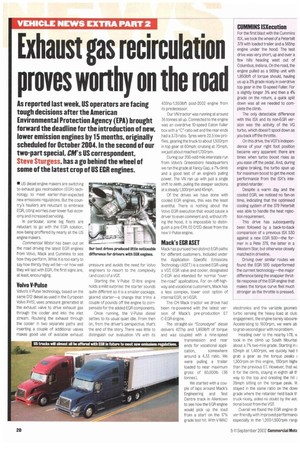CUMMINS ISXecution
Page 20

If you've noticed an error in this article please click here to report it so we can fix it.
For the first blast with the Cummins ISX, we took the wheel eta Peterbilt 379 with loaded trailer and a 565hp engine under the hood. The test drive was very short, up and over a few hills heading west out of Columbus, Indiana. On the road, the engine pulled as a 565hp unit with 1,8501bIt of torque should, hauling us up a 3% grade nicely in overdrive top gear in the 13-speed Fuller. For a slightly longer 3% and then a 4% grade on the return, a quick spit down was all we needed to complete the climb.
The only detectable difference with this ISX and its non-EGR version was the activity of the VG turbo, which doesn't spool down as you back off the throttle.
On this drive, the VGT's independence of your right foot position became very apparent; there are times when turbo boost rises as you ease off the pedal. And, during engine braking, the turbo spun up for maximum boost to get the most performance from the ISX's integrated retarder.
Despite a warm day and the cooled EGR, we noticed no fan-on time, indicating that the optimised coding system of the 379 Peterbat was able to handle the heat rejection requirement.
This drive has subsequently been followed by a back-to-back comparison of a previous ISX 530 against a new EGR 500—the former in a Pete 579, the latter in a Western Star, but otherwise closely matched in driveline.
Driving over similar routes we found the EGR 500 outperformed the current technology—the major difference being the snappier throttle response of the EGR engine that makes the torque curve feel much stronger as the throttle is pressed.




























































































































































